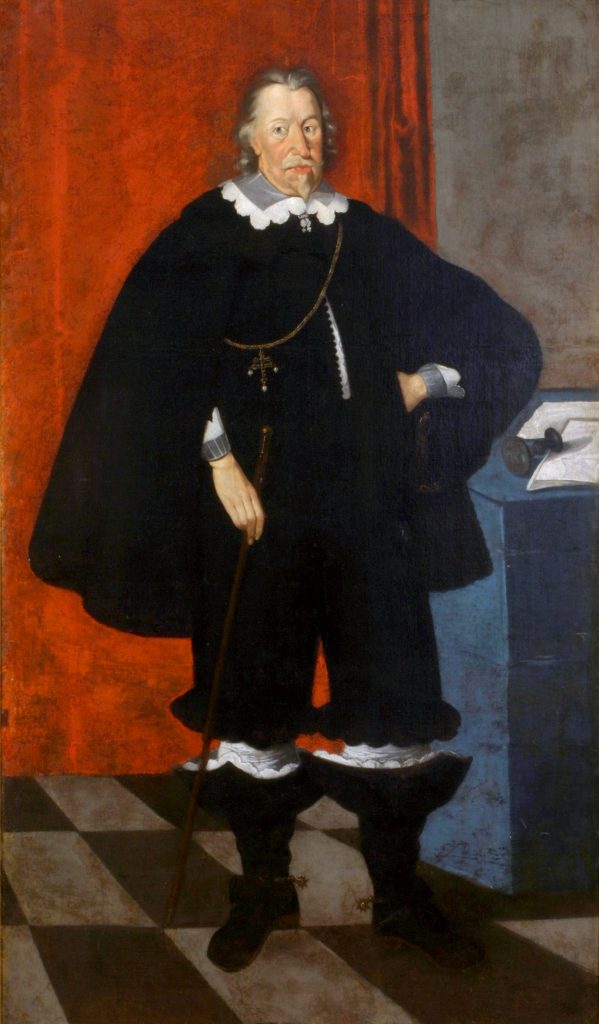State Archive in a Private Home
Jakub Mora was a rich goldsmith. He lived in a luxurious house in the heart of Vilnius in what today is Didžioji Street no. 19. In 1629 King of Poland and Grand Duke of Lithuania Sigismund Vasa issued a privilege that charged him with a somewhat unusual, especially considered from the 21th century perspective, obligation of guarding a part of the state archive, the Lithuanian Metrica.
This privilege is the earliest of its kind, but several others were issued soon after: in April 1636 Jan Kluczata (Didžioji Street 13) and in December of the same year Gregory Kozlanowski (Didžioji Street 11) were charged with guarding the archive.
More documents of this type remain. All of their recipients were named keepers of the archive.
Private homes for public documents
This was partly a forced decision, because the Lower Castle was simply too small to accommodate the ever-growing archive of the royal chancellery.
In the late 16th century Chancellor of Lithuania Leon Sapieha ordered to copy all existing books of the Lithuanian Metrica, as most of the old ones were worn out. Scribes copied documents from the old books and by doing so created the new archive consisting of some 150 books. The honourable residents of Vilnius were entrusted with their security.
Their homes stood out, for they were built of stone and brick in the predominantly wooden city. The ground floor housed a shop, the inner yard was used as a storage area, while the family actually lived on the first and second floor. Many affluent homes accommodated small private – and entirely legal – distilleries.
Lithuanian Metrica explained
That’s an extensive collection of documents from the Chancellery of Grand Dukes of Lithuania, consisting of 665 known books. The archive includes every kind of act ranging from royal privileges confirming land ownership, titles, and offices to court rulings, diplomatic correspondence, financial reports, property inventories, testaments, letters etc.
“
The earliest document of the Metrica is the treaty with Livonia signed by the Grand Duke Algirdas and the Grand Duke Kęstutis that dates back to 1367. The latest documents date to the end of the 18th century.
The earliest document of the Metrica is the treaty with Livonia signed by the Grand Duke Algirdas and the Grand Duke Kęstutis that dates back to 1367. The latest documents date to the end of the 18th century.
By the end of the 18th century the Polish and Lithuanian Commonwealth was partitioned and disappeared from the maps and the Lithuanian Metrica (at the time consisting of 834 books stuffed in 14 boxes and additional 16 rolls of parchments) fell into Russian hands and was taken to Saint Petersburg. There the archive of the old Lithuanian state was divided in a barbaric intervention. Up to this day the archive remains in Russia, while Lithuanian archives hold the microfilm copies of the Lithuanian Metrica.
From Trakai to Vilnius
“
Since the middle of the 14th century, the developing archive was kept inside the ducal palace in Trakai, 30 kilometres west of Vilnius. Important documents and international treaties were kept in the treasury of the castle. They were stored in chests or sacks, alongside other valuables.
The Lithuanian Metrica was formed in the 14th century but it never had one designated keeping place. Metrica was always en route following the chancellors and other officials of the chancellery. Since the middle of the 14th century, the developing archive was kept inside the ducal palace in Trakai, 30 kilometres west of Vilnius. Important documents and international treaties were kept in the treasury of the castle. They were stored in chests or sacks, alongside other valuables.
In the beginning of the 16th century the original documents were moved to the Lower Castle in Vilnius, where the scribes made their hand-written copies on demand. Moreover, court records from the courts of voivode of Vilnius and GDL’s marshals also made their way to the treasury of the Lower Castle, and so the royal archive started accumulating documents written in other institutions.
Vilnius elite guarding the archive
A total of six royal privileges concerning the private storage of Lithuanian Metrica were issued to residents of 17th century Vilnius. Only the houses standing around the Town Hall Square, Didžioji and Stiklių streets were selected. They had enough room to store the documents and were able to protect them from thieves and fire. These houses belonged to the Vilnius elite keepers – wealthy merchants and artisans – and the keepers were selected by the chancellors of Lithuania, such as Albrycht Stanisław Radziwiłł (1623–1656).
Do You Know?
Taking care of the archive books was a responsibility that carried its own benefits. After all, the owners of the chosen houses were exempt from housing all kinds of visitors of the city that ranged from foreign diplomats to court musicians. The exemption remained valid, at least formally, even after the home owner’s death or the new owners if the house was sold.
Yet sometimes even a royal privilege could not guarantee peace. Baranowicz, the owner of No. 11 on Didžioji Street, filed a court complaint in 1666 stating that last year his house was literally taken by force by a provincial treasurer Kazimierz Nieciszewski and his wife Anna Grobicka. They broke the doors to many chambers and the cellar, but most importantly, they stole several chests of valuables containing the books of the Lithuanian Metrica.
Raimonda Ragauskienė









